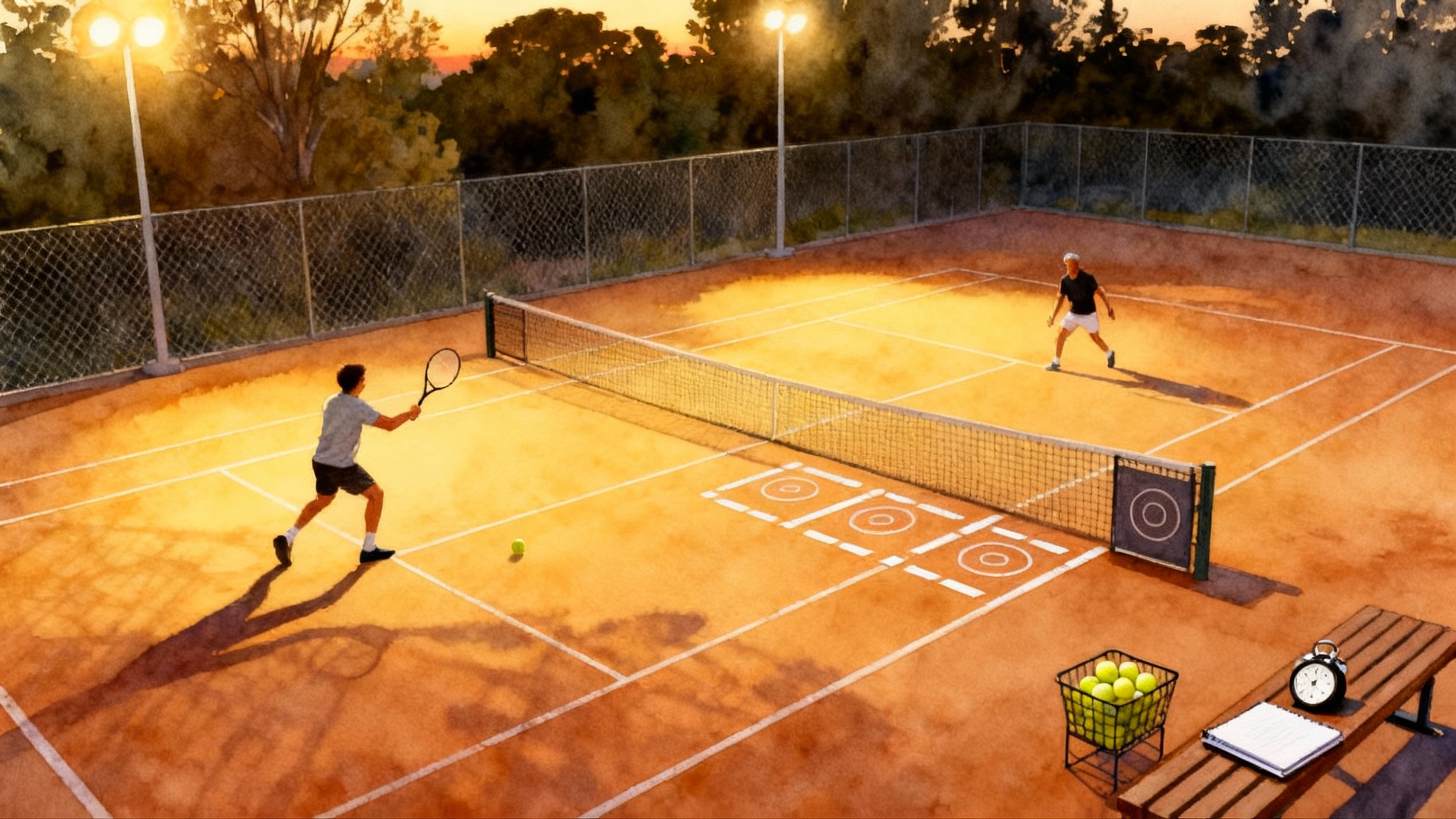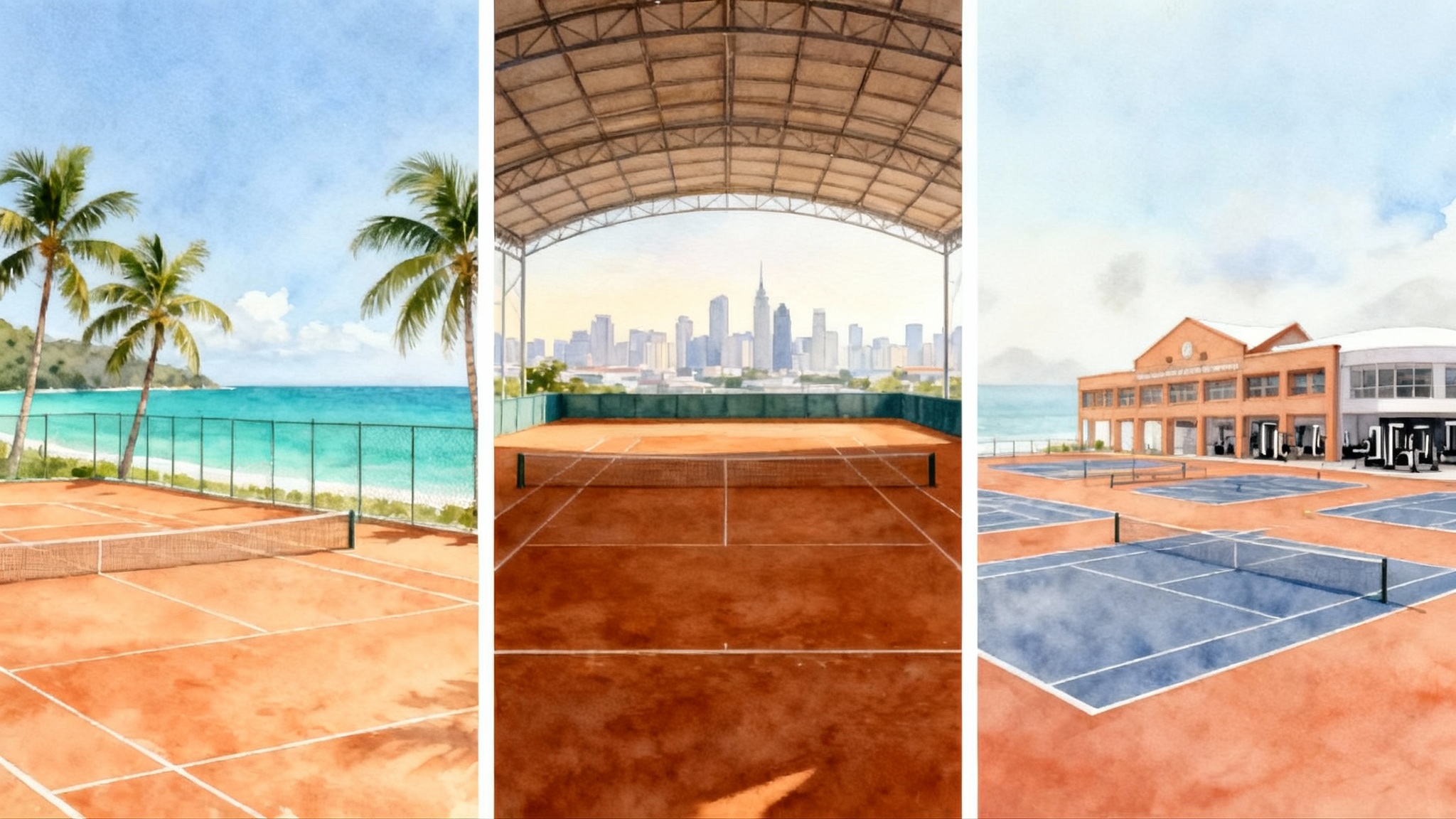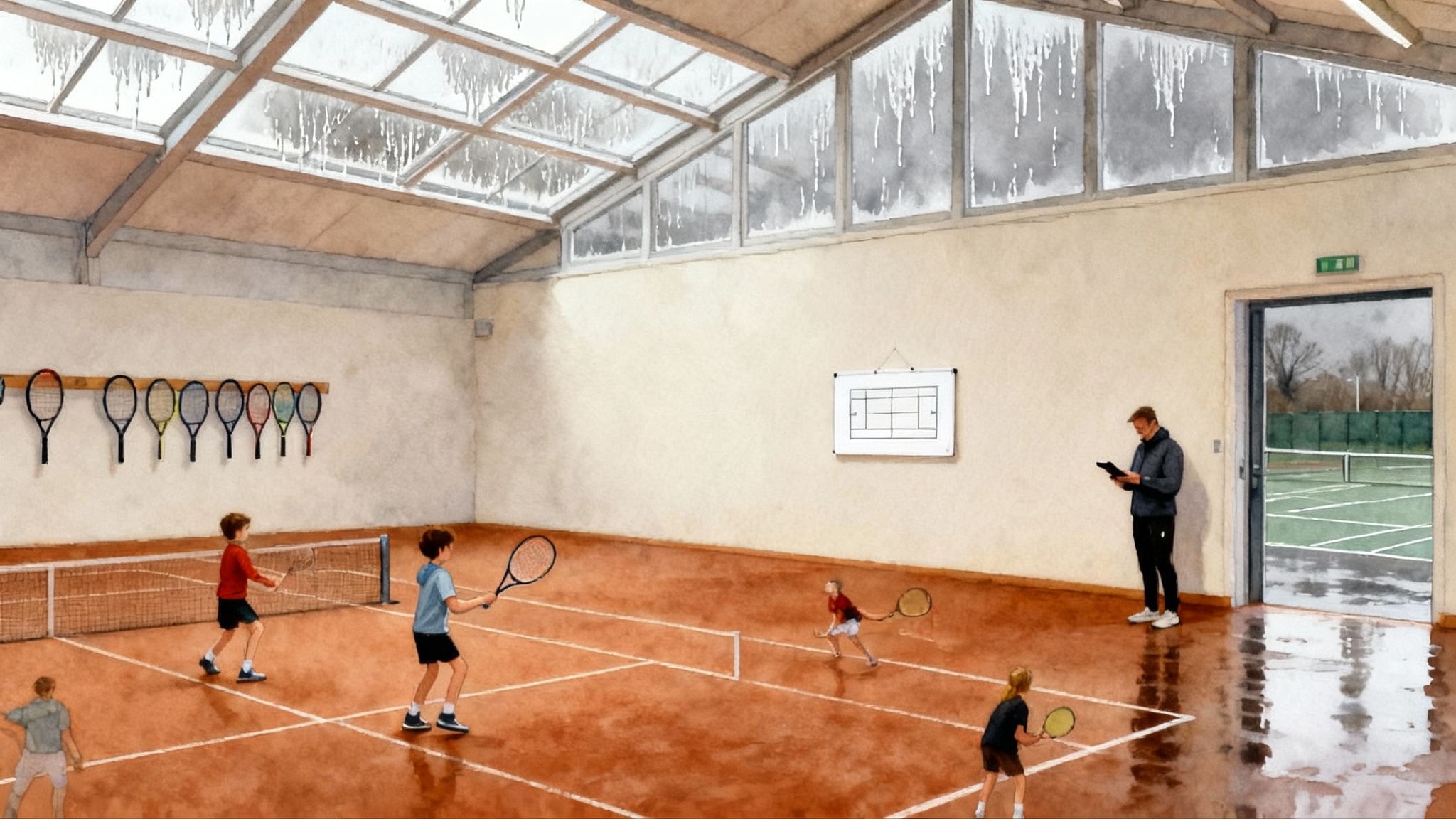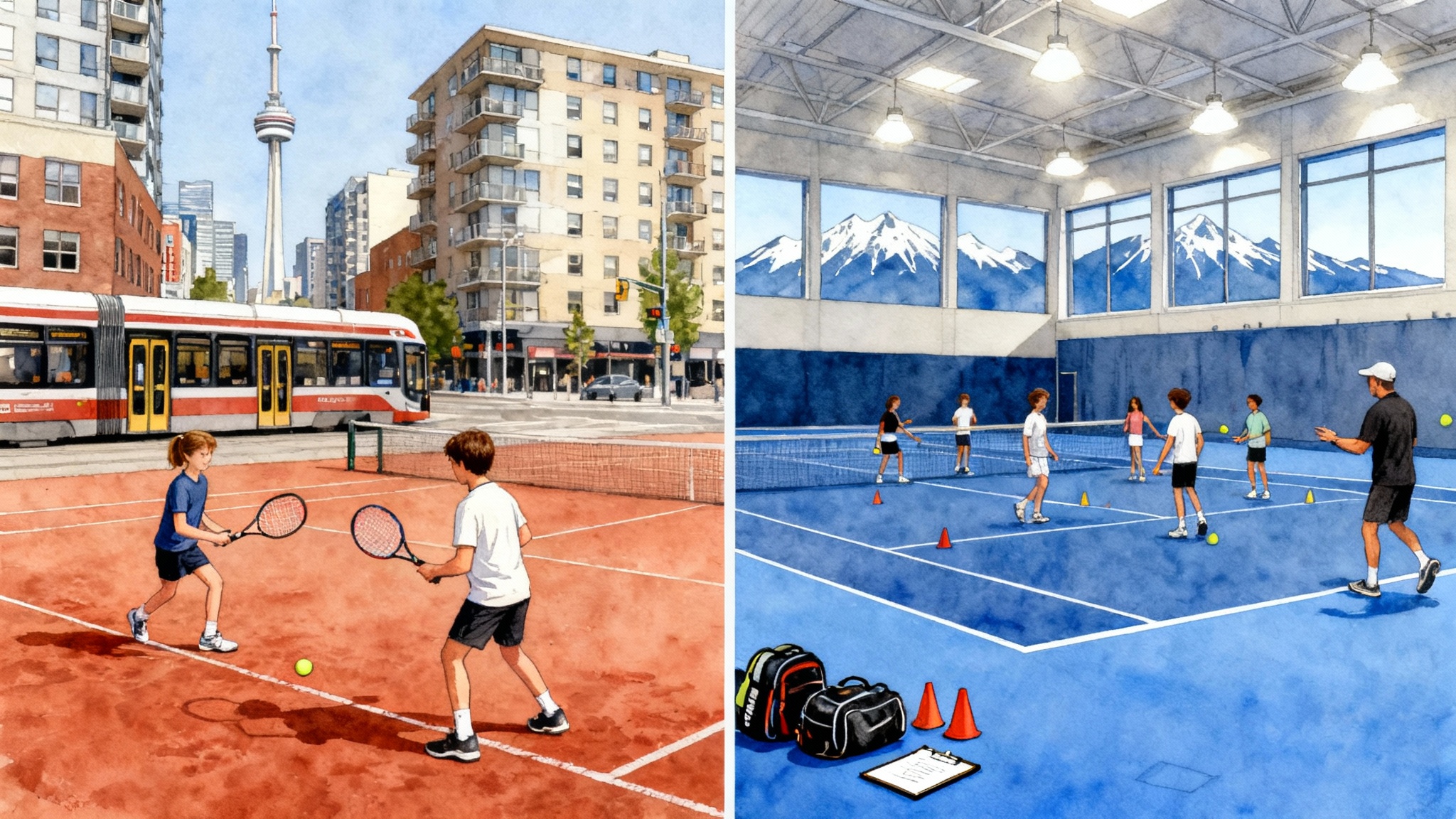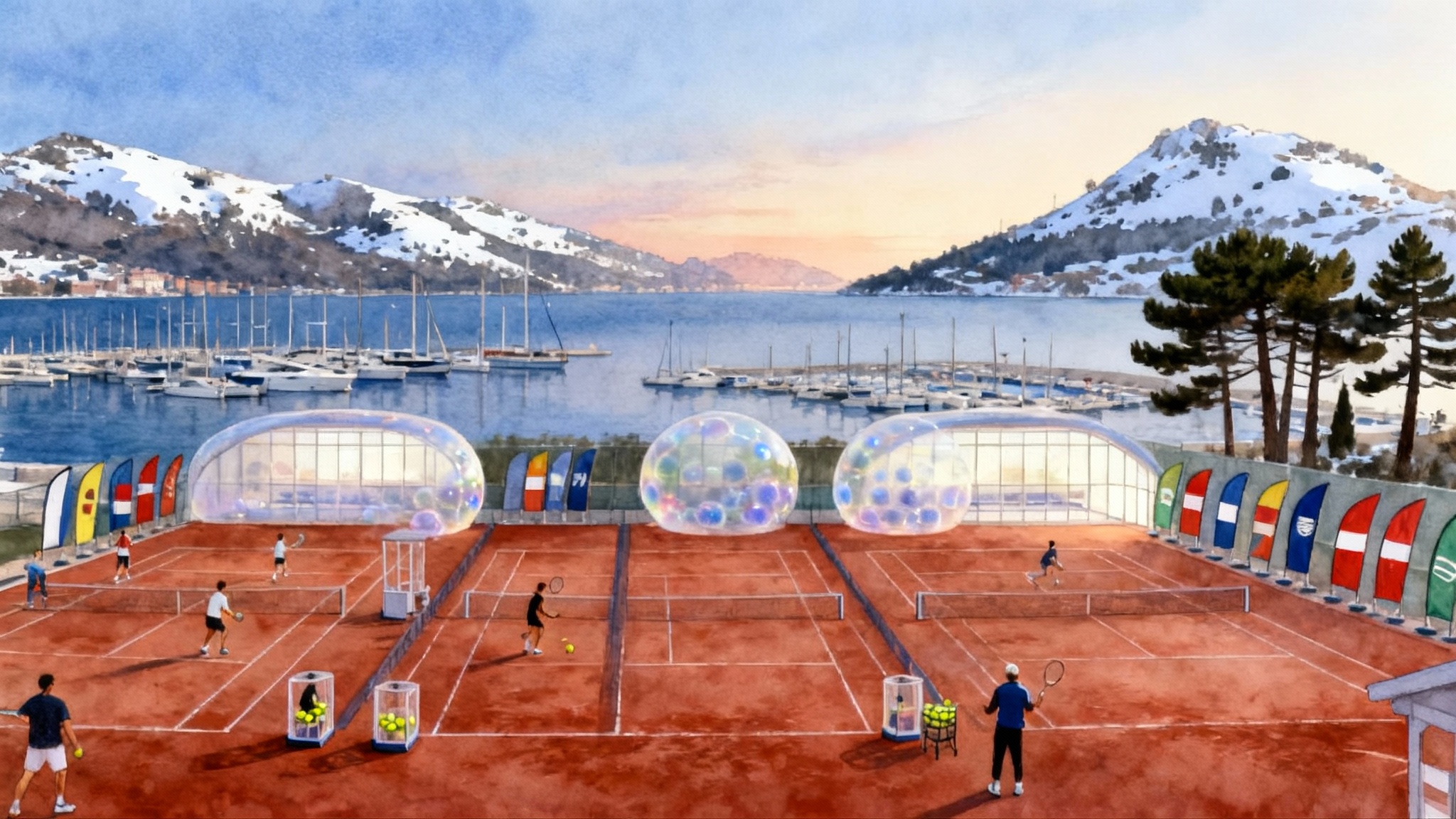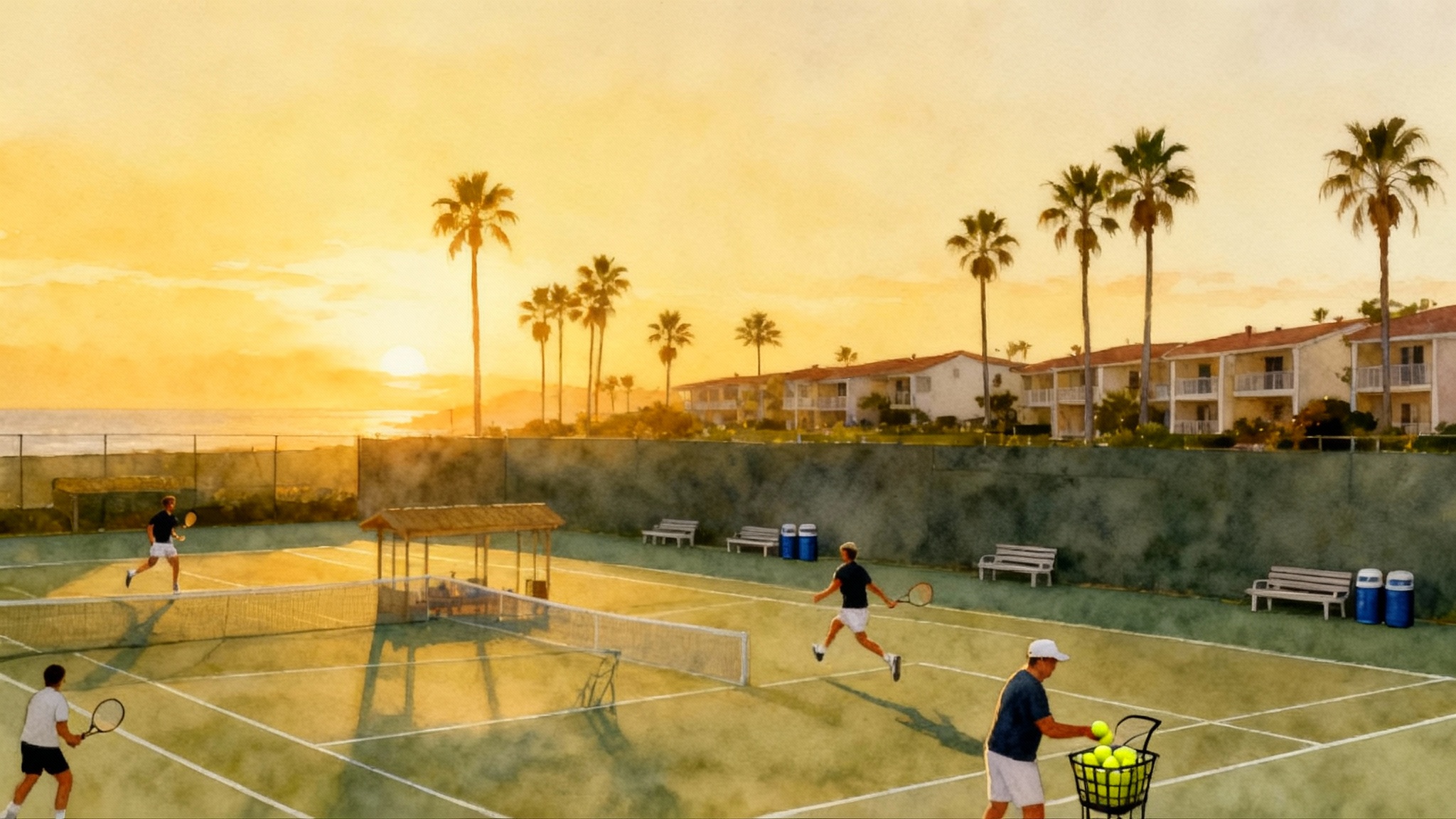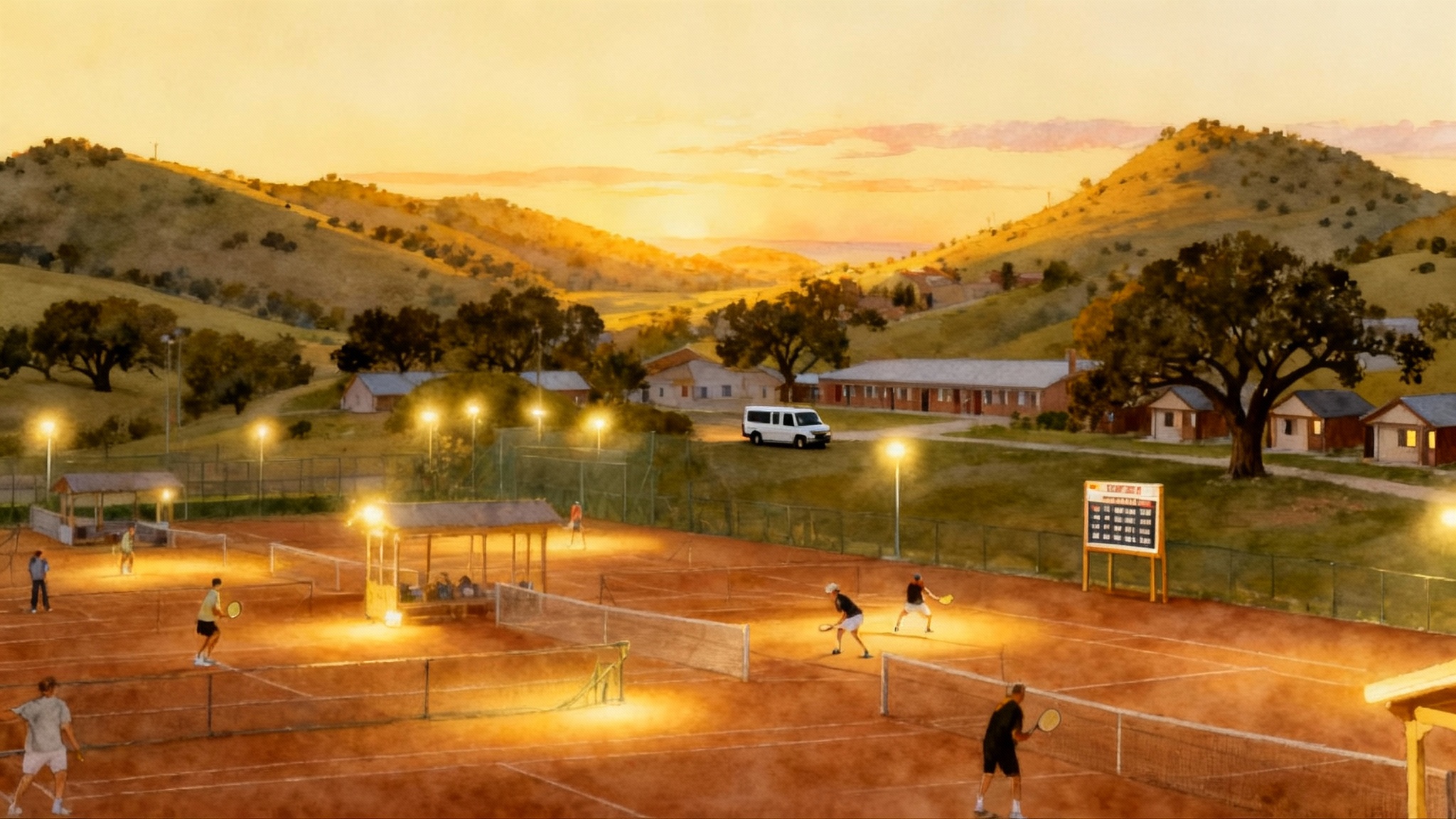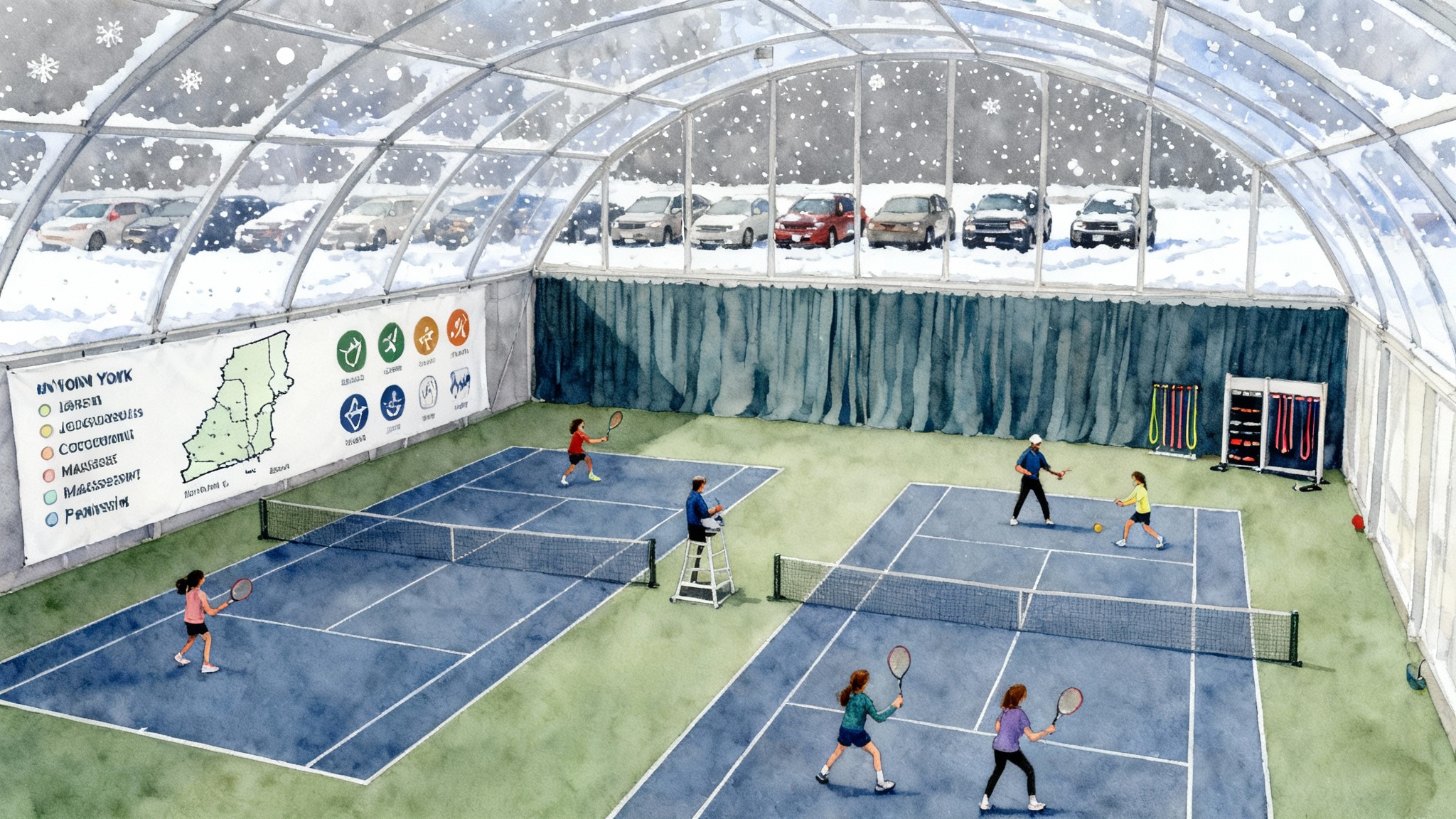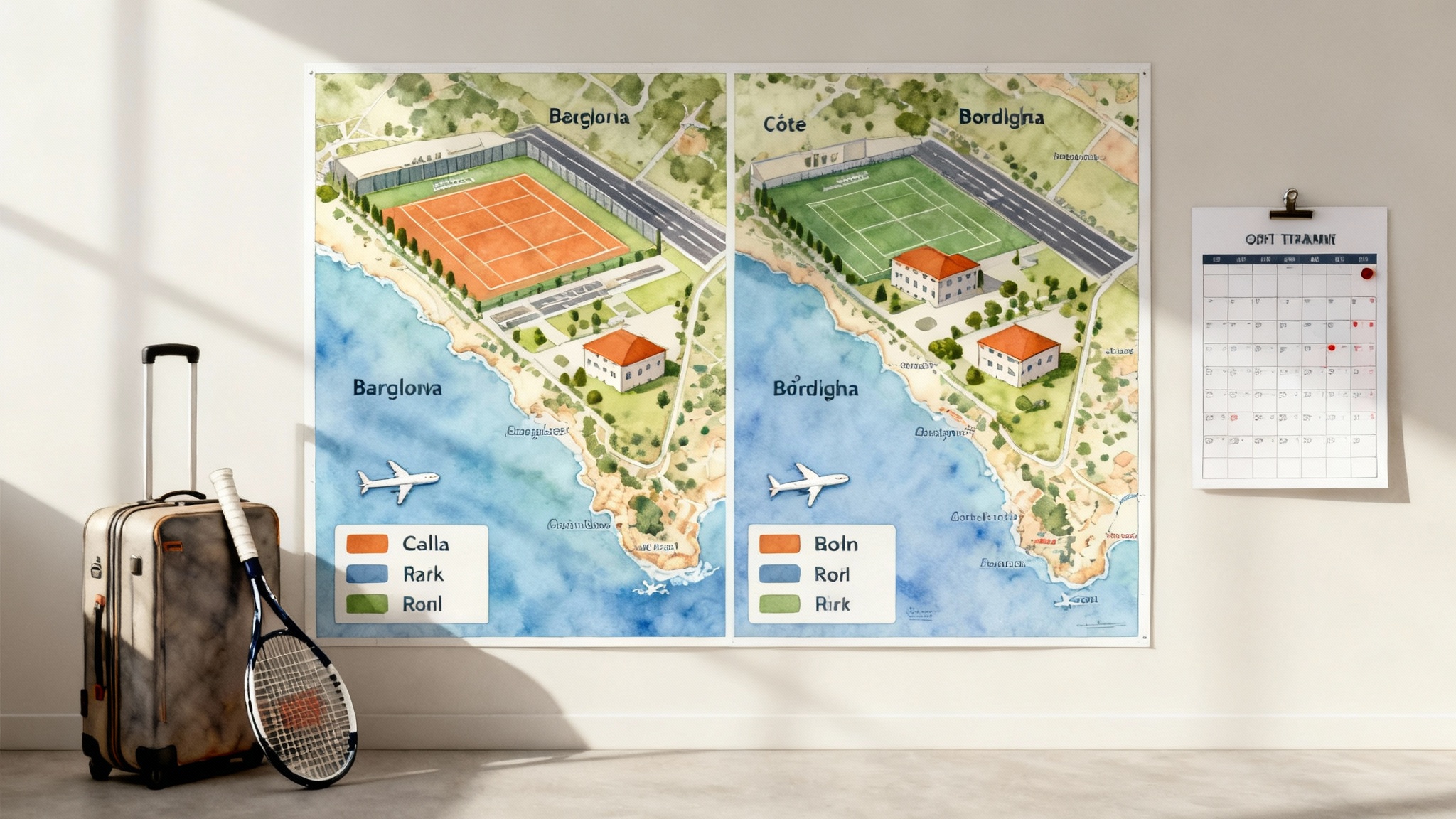Best Florida Tennis Academies for Juniors 2025–2026 Guide
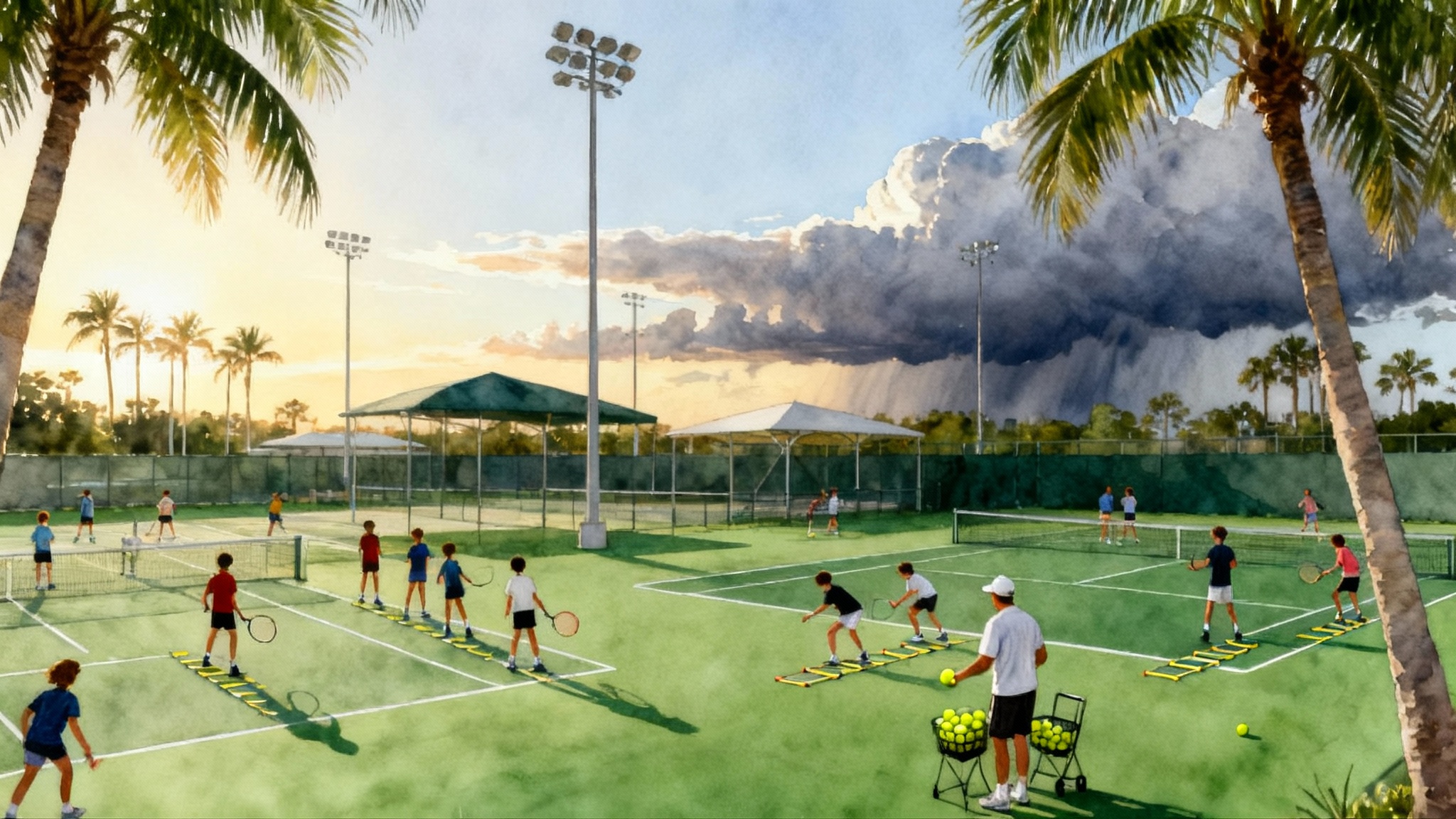
How to use this guide
Florida may be the best place in the United States to grow a junior tennis player. Tournaments run almost every weekend, the climate allows year-round court time, and the academy ecosystem is deep. This guide compares leading programs by region, focusing on what parents actually need to decide: coaching ratios and staff pedigree, surface mix and rare indoor backups, boarding and academics, weekly training loads with proper fitness and recovery, ratings progression signals, tournament travel density and costs, 2025–2026 price bands, plus heat and hurricane protocols.
We group programs by region and recommend best-for picks for different junior profiles. We also include two sample weekly schedules and a due-diligence checklist you can take on your visits.
Note on indoor courts in Florida: they are scarce. A notable exception is the USTA National Campus in Orlando, which includes six indoor hard courts within the Player Development complex. Details are in this overview of six indoor hard courts at USTA. If year-round indoor play is essential, see our Best Northeast indoor academies guide.
Miami–Broward
Representative programs: Saviano High Performance Tennis, Miami Beach Tennis Academy, several strong club-based high performance groups across Aventura, Plantation, Weston and Miami Beach.
- Coaching model and ratios: High-performance blocks typically run 1:4 to 1:6 on drilling courts, then expand to 1:6 to 1:8 during live ball and match play. Saviano publishes a 1:4 target for select squads and is known for hands-on technical work. Club academies in Miami Beach and Aventura often cap courts at four or five players for Academy or Pre-Academy after-school sessions.
- Staff credentials: Saviano’s staff pedigree is well known in player development circles. In the broader area, you will find former NCAA players leading pods, plus visiting sparring from touring pros during off weeks. Ask who actually runs your child’s court daily and how often the head coach observes.
- Surfaces and backup: Most centers are green clay heavy with access to hard courts. Indoor backups are almost nonexistent locally, so tour-level rain management means covered fitness, video review, or a quick reschedule. Expect lightning delays to be common in summer afternoons.
- Boarding and academics: Miami–Broward is primarily commuter-based. Full-time students usually pair tennis with local or online schools such as American Heritage, Laurel Springs, Dwight Global, or Florida Virtual School. Host-family arrangements exist but require careful vetting.
- Weekly training load: Typical after-school programs run 2 to 3 hours per day, five days per week, with two or three fitness blocks built in. Full-time schedules for home-schooled athletes add morning tennis or fitness and supervised match play.
- Ratings and college placement: Programs track Universal Tennis Ratings and World Tennis Number. A realistic 12 to 18 month target for a dedicated 14U competitor is one to two UTR points, assuming consistent match volume. College placement from the top Broward pods is strongest for Division II and mid-major Division I unless the player is already in national contention.
- Tournaments and costs: South Florida packs USTA L7 through L3 events and several ITF weeks in Delray and Plantation, so many weekends require less than an hour of driving. A typical local weekend budget is entries plus gas and meals. Out-of-area ITFs add flights and two to three nights of lodging.
- 2025–2026 price bands: After-school high performance commonly ranges from about 700 to 1,900 dollars per month for three to five days weekly. Private lessons run 90 to 180 dollars per hour depending on the coach. Full-time customized training that adds mornings can push above 2,500 dollars monthly for commuters, not including academics.
- Safety and weather: Reputable programs use lightning detection, schedule earlier sessions in peak summer, and require frequent hydration and shade breaks. Ask if they track wet bulb globe temperature and have a written lightning and heat policy.
Best for: committed commuters who want strong technical coaching without boarding, families who value clay-court development, and players who can leverage dense local tournaments.
Palm Beach County
Representative programs: Evert Tennis Academy, Rick Macci Tennis Academy, One Tennis Academy, strong municipal centers in Boca and Delray, plus ProWorld Tennis Academy in Delray.
- Coaching model and ratios: Evert and Macci maintain small drilling ratios for technical blocks then scale for situational point play. One Tennis Academy publishes structured after-school packages with defined tennis, fitness, and occasional yoga blocks.
- Staff credentials: Evert blends veteran development coaches with college-placement specialists and regular fitness and mental skills staff. Macci is known for hands-on stroke work and a very high daily coaching presence.
- Surfaces and backup: Hard and green clay split is common. No true indoor courts on-site, so rain plans pivot to fitness, video breakdown, or secondary court sites.
- Boarding and academics: Evert offers boarding tied to its tennis program and partners with local schools for academics. Macci and One serve mostly commuters, with seasonal boarding options at times. Several families use Boca Prep, Hibernian, ICL Academy, Laurel Springs, or Florida Virtual School for academics.
- Weekly training load: Full-time tennis plus boarding can include 2 to 3 court sessions daily, integrated strength and movement, match analytics, and recovery. After-school tracks run 2 to 3 hours per day with two to four fitness sessions weekly.
- Ratings and college placement: Historically strong. You will find a steady pipeline to Division I through Division III programs. Expect transparent match-logging, WTN tracking, and college advising meetings in the spring. For next steps, use our 2025 college recruiting roadmap.
- Tournaments and costs: Delray hosts USTA and ITF events that draw strong fields. Within two hours you can play year-round from Miami to Vero Beach. Travel costs scale with ITF entry and hotel nights.
- 2025–2026 price bands: Full-time tennis with boarding at brand-name academies typically ranges from the mid 60,000s into the 70,000s for the academic year, with academics either bundled or paid to partner schools. Non-boarding full-time tennis is commonly in the mid 30,000s to mid 40,000s. After-school high performance ranges from about 1,300 to 3,400 dollars per month depending on hours and coaching tier.
Best for: families seeking name-recognition programs with deep college placement support, boarding plus structured college-prep academics, and strong technical progress for 12U to ITF-track teens.
Orlando
Representative programs: USTA National Campus public programs, MG Tennis at Lake Cane, Orlando Tennis Academy, Gooding Todero Academy groups in Lake Nona.
- Coaching model and ratios: Club-led academies publish clear pods by UTR band, for example tournament training for UTR 1 to 4, junior academy in the 4 to 6 range, and high performance above that. Ratios run 1:4 to 1:6 on drilling courts.
- Surfaces and indoor backup: Orlando is the rare Florida region with indoor access via the USTA National Campus Player Development building. When storms roll in, programs pivot to fitness, video, or the campus’s indoor inventory when available to the public by schedule. This reduces weather risk relative to South Florida.
- Boarding and academics: Most Orlando programs are commuter-based, though some families use host arrangements or enroll in private schools near Windermere and Lake Nona. USTA National Campus is not a traditional boarding academy for the public, so plan academics independently.
- Weekly training load: After-school squads run 2 to 3 hours per day, two to four days per week. High performance tracks add daytime windows for home-schooled athletes. Fitness is integrated and usually includes movement, mobility, and basic strength.
- Ratings and college placement: Orlando’s collegiate scene, including the University of Central Florida on campus, brings frequent college dual matches and exposure. Programs emphasize WTN and UTR tracking through verified match play.
- Tournaments and costs: The Orlando area hosts frequent USTA events from Level 7 to Level 3, plus college showcase weekends. That keeps travel budgets modest for most of the season.
- 2025–2026 price bands: Monthly commuter packages for two to four days per week typically run 350 to 900 dollars, with private lessons 65 to 140 dollars per hour. Seasonal high performance camps are widely available between 160 and 1,000 dollars per week, depending on hours and options.
Best for: budget-conscious commuters, families who want the most reliable weather plan in Florida thanks to the USTA’s indoor courts, and players building from sectional to national level.
Tampa and the Gulf Coast
Representative programs: IMG Academy in Bradenton, Saddlebrook in Wesley Chapel, Gomez Tennis Academy in Naples.
- Coaching model and ratios: Large programs maintain technical pods on 1:4 to 1:6 courts in drilling blocks, then expand for point construction and match sets. You will see robust strength and conditioning departments and recovery staff at IMG and Saddlebrook.
- Surfaces and backup: IMG and Saddlebrook offer both hard and clay. IMG promotes several indoor courts for event play and select training which is helpful during lightning holds. Naples programs add a boutique feel with green clay and hard court mix.
- Boarding and academics: This region leads Florida for integrated boarding plus academics. IMG is a full boarding school with in-house academics. Saddlebrook pairs its academy with Saddlebrook Preparatory School. Naples programs partner with SEVP-certified schools for F-1 visa students.
- Weekly training load: Full-time boarding schedules commonly include morning sport-specific training, midday academics, and afternoon tennis with fitness, film, and recovery, plus supervised weekend match play.
- Ratings and college placement: IMG and Saddlebrook have extensive college placement operations. Expect structured college nights, video packages, and coach references. Boutique Naples programs place well into Division II and Division I for strong performers.
- Tournaments and costs: The Gulf Coast has a steady event flow from Sarasota to Fort Myers and into Tampa. IMG also hosts events on campus which lowers logistics for boarders. Out-of-state ITFs add significant airfare and hotel costs.
- 2025–2026 price bands: IMG lists 2025–2026 tennis boarding tuition bands in the low 70,000s to mid 90,000s depending on age and program tier, see 2025–2026 IMG tennis tuition. Saddlebrook publishes integrated tennis, academics, and boarding packages in the mid to upper 70,000s for the year. Boutique Naples boarding packages are usually lower, and commuter high performance tends to be 1,000 to 2,500 dollars monthly.
Best for: international families who need turnkey boarding plus visa-ready academics, college-focused juniors who want a school-like daily structure, and ITF-track teens who benefit from on-campus events and services.
Clear best-for picks
- Best for 12U foundations: Orlando club academies that publish ball-color progressions and UTR bands, plus Evert’s developmental tracks for technique and movement. The combination of smaller courts, green dot progression, and consistent match days produces measurable skill jumps.
- Best for ITF-track teens: IMG in Bradenton for integrated services and on-campus tournaments, Saddlebrook for the academic pairing and travel coaching, and Evert or Saviano for technical refinement and individualized planning. Choose based on your player’s current UTR, need for boarding, and how much individual attention they require.
- Best for budget commuters: MG Tennis in Orlando and Miami Beach club academies where monthly plans under 1,000 dollars for two or three days per week still include structured fitness and tournament planning.
- Best for international families: IMG and Saddlebrook for school plus boarding under one roof, or Gomez Tennis Academy in Naples with SEVP partner schools when you prefer a boutique environment and smaller cohorts.
Sample weekly schedules
Sample full-time boarding week, high school age
- Monday to Friday
- 7:00 Breakfast and mobility
- 8:00 Period 1 academics, 90 minutes
- 9:45 Period 2 academics, 90 minutes
- 11:30 Lunch and study hall
- 12:30 On-court technical block, 90 minutes, 1:4 to 1:6 ratio
- 14:15 Fitness block, 45 minutes, movement and tennis-specific strength
- 15:15 Point construction and live sets, 90 minutes
- 17:00 Recovery, athletic training room, and video review, 30 to 45 minutes
- 18:30 Dinner, study hall and lights-out windows
- Saturday
- Team match play or USTA event travel
- Sunday
- Recovery session and optional private lesson
Sample commuter after-school week, 12U to 14U
- Monday to Friday
- 15:30 Arrival and warm up
- 15:45 Technical stations, 60 minutes, 1:4 or 1:6 ratio
- 16:45 Live ball and match play, 45 to 60 minutes
- 17:45 Fitness or footwork circuit, 20 to 30 minutes
- 18:15 Cooldown, parent update, homework
- One weekday off for academic workload as needed
- Weekend
- One local USTA tournament or club match day per month
2025–2026 price bands at a glance
- Boarding plus full-time tennis with integrated academics: roughly 70,000 to upper 90,000 dollars per academic year at the largest campuses. Smaller boarding programs with partner schools tend to price lower.
- Full-time tennis, non-boarding: about 30,000 to mid 50,000 dollars per year depending on hours, coach tier, and whether academics are separate.
- After-school high performance: about 700 to 1,900 dollars per month for three to five days weekly. Some elite daily tracks cost more when they run six hours per day.
- Weekly camps: about 1,100 to 3,500 dollars per week depending on boarding, added performance training, and extra one-to-one coaching.
Your family’s all-in budget should add tournament entries, private lessons, stringing, travel coaching, physiotherapy, and travel. For ITF-heavy schedules, travel can rival tuition.
Heat, lightning, and hurricane protocols to verify
- Heat management: Ask whether the academy measures wet bulb globe temperature, what thresholds trigger longer breaks or session rescheduling, and how hydration is managed. Look for shade structures, ice towels, and cold water available on every bank of courts.
- Lightning: Florida storms escalate fast. Ask whether the facility uses automatic lightning detection, at what distance they clear courts, and what the required all-clear interval is before play resumes.
- Hurricanes and tropical storms: Request a written policy for closures, boarding student evacuation or sheltering, missed-session credits, and how communication works if cell service is intermittent. If you are an international family, confirm who holds custody if airports close.
How to read UTR and WTN signals
- Baselines by age are broad, not destiny. As a rough orientation, many competitive 12U players sit between UTR 3 and 6. By 16U, varsity-level girls often span UTR 6 to 9 and boys 8 to 11 with wide variance by region and growth stage.
- College translation: Look at rosters for your target schools and note the WTN and UTR of current lineup players, then set a two-year plan with your coach. Verified match play against slightly higher-rated opponents is the fastest way to nudge ratings.
- Track real match volume: Families often over-index on lesson hours. Ask the academy for a monthly match count target, for example 8 to 12 verified matches, and make sure weekend scheduling supports it.
For additional context on international pathways and surfaces, compare models in our Spain vs France vs Italy guide.
What to ask on your academy visits
Use this checklist to avoid surprises. You can also print a version from our site: Parent due-diligence checklist.
Coaching and development
- What is the exact coach-to-player ratio in technical blocks, live ball, and match play, and who is the court leader each day
- How often does the head coach observe or teach your child’s court
- What is the written development plan for the next 90 days, and how is it reviewed
- Is video analysis included, how often, and with what feedback loop
Fitness and recovery
- Who designs the strength and conditioning program and are loads age appropriate
- How are injuries handled, what recovery tools are available, and who clears return to play
Academics and boarding
- If boarding, who is the dorm parent to student ratio overnight, and what is the study hall structure
- If academics are separate, which schools are approved and who coordinates schedules, testing windows, and NCAA eligibility
Ratings and competition
- How will verified UTR and WTN match play be built into each month
- What is the typical tournament calendar by rating band and who organizes entries and travel
Operations and safety
- Exact heat, lightning, and air-quality protocols and who makes the call to stop or resume
- Hurricane plan for boarding and commuters, including communication, cancellations, and refunds or credits
- Transportation options for airport runs, daily shuttles, and tournament travel, with costs and supervision
Financials
- What is included in tuition and what is not, for example stringing, physio, travel coaching, or airport transfers
- Are scholarships, international fees, deposits, or installment service fees required
Putting it together
Florida’s depth is both a gift and a challenge. The right choice is not about a brand name alone. It is about matching your player’s current needs to a daily environment that delivers the right ratio on court, enough verified matches, a surface mix that suits their goals, and a schedule your family can realistically support for many months. Visit two regions if you can, because travel density and weather patterns feel different on court in Miami, Orlando, and Bradenton.
If you need a turnkey solution with academics and boarding, start your shortlist on the Gulf Coast with IMG and Saddlebrook, then add Evert if you prefer a smaller boarding footprint in Boca with academics through partner schools. If you are a commuter family, Orlando and Miami–Broward offer strong value and nonstop tournaments that build ratings without constant hotel nights. A cautious parent asks fewer general questions and more about numbers: ratios, hours, match counts, and budgets. Do that, and your child’s progress will stop feeling like a mystery and start looking like a plan.
